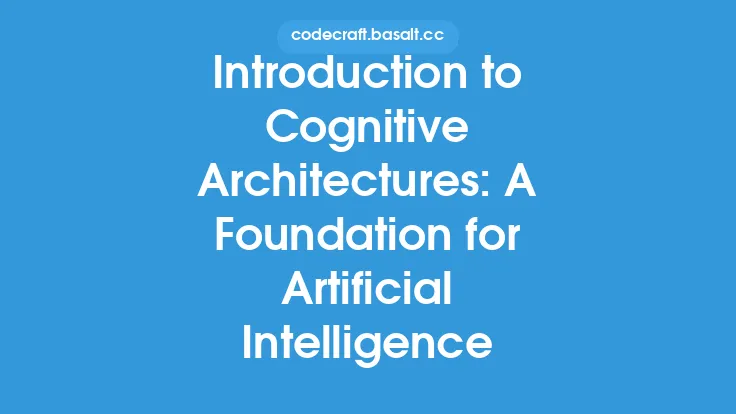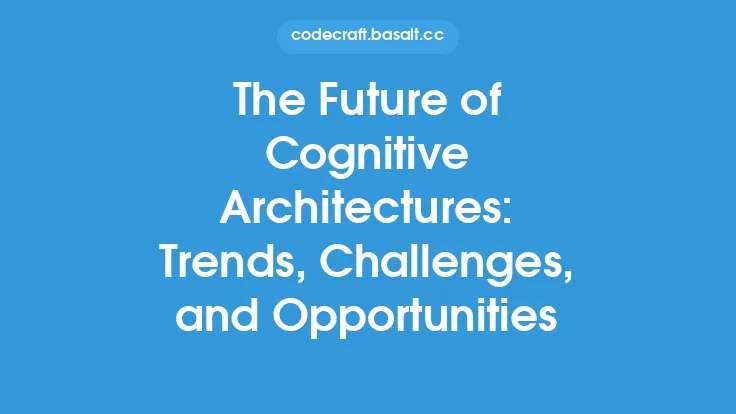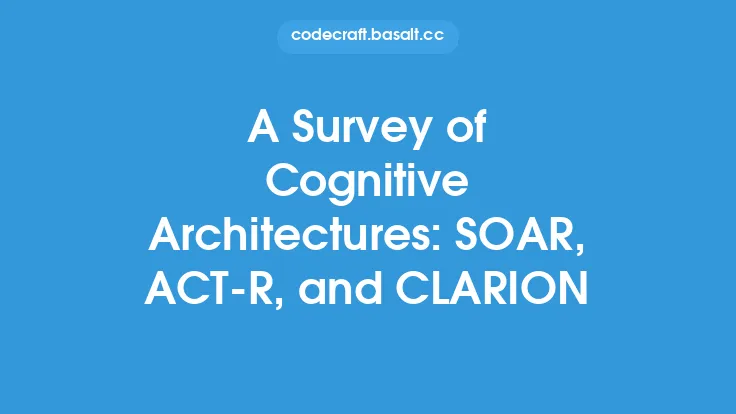Cognitive architectures play a crucial role in the development of Artificial General Intelligence (AGI), as they provide a framework for integrating multiple AI systems and enabling them to work together seamlessly. A cognitive architecture is a software framework that simulates the human cognitive process, including perception, attention, memory, reasoning, and decision-making. It provides a structured approach to building intelligent systems that can perceive, reason, and act in a human-like manner.
History and Evolution of Cognitive Architectures
The concept of cognitive architectures dates back to the 1980s, when researchers began exploring ways to simulate human cognition using computer models. One of the earliest cognitive architectures was SOAR, developed in the 1980s by John Laird, Allen Newell, and Paul Rosenbloom. SOAR was designed to simulate human problem-solving abilities and was used in a variety of applications, including natural language processing and computer vision. Since then, numerous other cognitive architectures have been developed, including ACT-R, CLARION, and LIDA. Each of these architectures has its strengths and weaknesses, and they have been used in a range of applications, from robotics and autonomous vehicles to healthcare and finance.
Key Components of Cognitive Architectures
A cognitive architecture typically consists of several key components, including a knowledge representation system, a reasoning engine, a decision-making mechanism, and a learning mechanism. The knowledge representation system provides a framework for representing and organizing knowledge, while the reasoning engine enables the system to draw inferences and make decisions based on that knowledge. The decision-making mechanism selects the best course of action based on the system's goals and preferences, and the learning mechanism enables the system to adapt and improve over time. Additionally, cognitive architectures often include modules for perception, attention, and memory, which enable the system to interact with its environment and retain information over time.
Role of Cognitive Architectures in AGI
Cognitive architectures play a critical role in the development of AGI, as they provide a framework for integrating multiple AI systems and enabling them to work together seamlessly. AGI requires a system to be able to perceive, reason, and act in a human-like manner, and cognitive architectures provide a structured approach to building such systems. By providing a common framework for representing knowledge, reasoning, and decision-making, cognitive architectures enable different AI systems to communicate and cooperate with each other, leading to more robust and flexible intelligent systems. Furthermore, cognitive architectures can be used to simulate human cognition and provide insights into human intelligence, which can be used to develop more advanced AI systems.
Technical Challenges and Limitations
Despite the importance of cognitive architectures in AGI, there are several technical challenges and limitations that must be addressed. One of the main challenges is the complexity of human cognition, which is still not fully understood. Cognitive architectures must be able to simulate human cognition accurately, which requires a deep understanding of the underlying cognitive processes. Additionally, cognitive architectures must be able to scale to complex, real-world problems, which requires significant computational resources and advanced algorithms. Furthermore, cognitive architectures must be able to handle uncertainty and ambiguity, which is a fundamental challenge in AI research.
Applications of Cognitive Architectures
Cognitive architectures have a wide range of applications, from robotics and autonomous vehicles to healthcare and finance. In robotics, cognitive architectures can be used to enable robots to perceive, reason, and act in a human-like manner, leading to more advanced and flexible robotic systems. In healthcare, cognitive architectures can be used to analyze medical data and provide personalized recommendations for patients. In finance, cognitive architectures can be used to analyze market data and make predictions about future market trends. Additionally, cognitive architectures can be used in education, entertainment, and other fields, leading to more advanced and interactive systems.
Conclusion and Future Directions
In conclusion, cognitive architectures play a crucial role in the development of AGI, as they provide a framework for integrating multiple AI systems and enabling them to work together seamlessly. While there are several technical challenges and limitations that must be addressed, the potential benefits of cognitive architectures are significant. As research in cognitive architectures continues to advance, we can expect to see more advanced and flexible intelligent systems that can perceive, reason, and act in a human-like manner. Future directions for research in cognitive architectures include developing more advanced algorithms and models, integrating cognitive architectures with other AI systems, and applying cognitive architectures to real-world problems. By pursuing these research directions, we can unlock the full potential of cognitive architectures and develop more advanced and intelligent systems that can benefit society in a wide range of ways.





